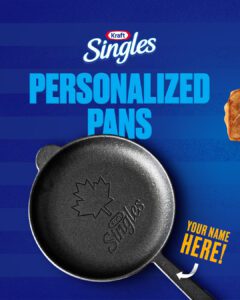The pandemic changed the way brands think about and do business with consumers, and it also changed the way marketing organizations create and execute campaigns. Smart marketers have reimagined the traditional marketing funnel as an “orbit” with a new, transaction-based model as its driving force: “Experiential Commerce.” And within the brand orbit, an evolution of the omnichannel view, marketers pull and crisscross levers to engineer a path to purchase.
The goal of experiential marketing has always been to generate an impact on brand, but driving a measurable transaction has often been a challenge. But with Experiential Commerce, brands are feeding their campaigns, their databases, and ultimately, their bottoms lines with smarter, more engineered, and digitally led marketing strategies.
Brands and properties are embracing this model with content- and digital-focused missions. Here, we explore five doing it well.
1.) Kraft-Heinz Canada’s first-party data boost.

(CNW Group/Kraft Heinz Canada)
Kraft-Heinz Canada’s in-house social media agency, The Kitchen, has created a content-first platform that delivers news, tips and recipes to engage current customers and help identify intenders for products. Kraft Dinner (known as Kraft Macaroni & Cheese in the U.S.), features content that positions the macaroni as an ingredient or a base for other dishes, like casseroles, and conducts social listening by soliciting ideas from followers on a routine basis. Indeed, more uses for the product results in more reasons to keep the pantry stocked with multiple boxes.
But the brand capitalized on comfort food consumption amid the pandemic, and the opportunity to capture valuable first-party data, by launching a “Personalized Pans” contest to engage consumers cooking at home. Consumers could enter to win a pan with their family name engraved on the handle and one of five icons engraved in the center that would be “grilled” onto the top of grilled cheese sandwiches (think: hockey sticks, maple leaves). Tens of thousands of consumers also voted on the icon choice, supplying the brand with email addresses and juicy preference data.
2.) Starbucks’ personalization machine.
Marketers look at Starbucks as the golden child of loyalty programs. For good reason. The order-ahead Starbucks App eases pain points by allowing consumers to seamlessly pick up and pay for drinks and food items without their wallets (hello, commerce). It also anticipates behaviors by pushing specialized, geotargeted or segmented offers around the time of day that they’re typically ordering based on purchase history (hello, offer redemption and preference data).
But the brand, put simply, slips into consumers’ everyday routines with bursts of personalized engagements, both digital and physical, from push notifications, to names written on cups, to physical experiences like in-store events, to seasonal merchandise—heck, consumers can even run into the brand in the aisle at the grocery store each week. The brand taps into the entire “brand orbit” to engage consumers and drive commerce.
3.) Netflix’s ‘Squid Game’ IRL inspirations.
Moving at the speed of culture is critical for modern marketing organizations to be successful. That means being able to act quickly with content in response to a viral moment. Take Netflix’s “Squid Game.” Netflix partnered with Walmart to start an e-commerce site of official merch from the series, but it was the fans that shaped it into a cultural movement.
TikTok users began sharing their recipes for “Dalgona candy” (featured in the series). One user amassed 13 million views on an instructional video. Consumers dressed up as characters for Halloween, bringing the series to life—in-person. Other viral moments ensued, including a real estate agent in Toronto who leveraged symbols from the series in his billboards. While not a traditional brand product, “Squid Game” is an example of the potential that lies in being content-first and giving consumers space to scale a marketing campaign.
4.) Nike’s owned path to purchase.
Nike did away with once traditionally important retail channels and now uses its own stores and owned e-commerce experiences to sell product, controlling the data and the transactions. Then, through software like Nike+, it collects reems of data on runners, their performances, their locations and their preferences, and pushes them access to Nike products, guidance and live events.
And then, through the Nike SNKRS app, consumers have access to product customization and personalization options as well as notifications on new releases, order tracking and exclusive content. Nike’s brand orbit is vast and designed to capture follower and consumers and keep them loyal and engaged on an ongoing basis with personalization, community-minded content and seamless transactions.
5.) Coachella’s media blitz.

(Pernod Ricard USA)
One could argue the Coachella Music & Arts Festival today is a digital phenomenon that manifests as an event in the real world. Its orbit is vast, with incentives and personalization at every touchpoint. It starts with the Coachella App that, among features, offers an AR camera with exclusive lenses for attendees to access leading up to and at the event—arguably, an event before the event, and a campaign in and of itself. Through Coachella Collectibles, the festival expands its e-commerce strategy with NFTs and a sustainability marketplace. Its YouTube channel operators like a real media channel with live broadcasts of artist interviews on-site, curated videos of performances, and micro documentaries about artists.
And then there are the official sponsors churning out programs like Absolut’s Absolut.Land metaverse that teleported attendees to the festival and served up prizes and collectibles, as well as official partner BMW, whose #RoadtoCoachella campaign is a social media experience anchored by influential artists—this year, Doja Cat, who traveled in a custom-wrapped all-electric BMW iX inspired by the artist’s latest album, “Planet Her.”
Talk about a brand orbit.
To learn more about Salt XC, click here. Learn more about Experiential Commerce here.
Image credit: iStock/wildpixel






